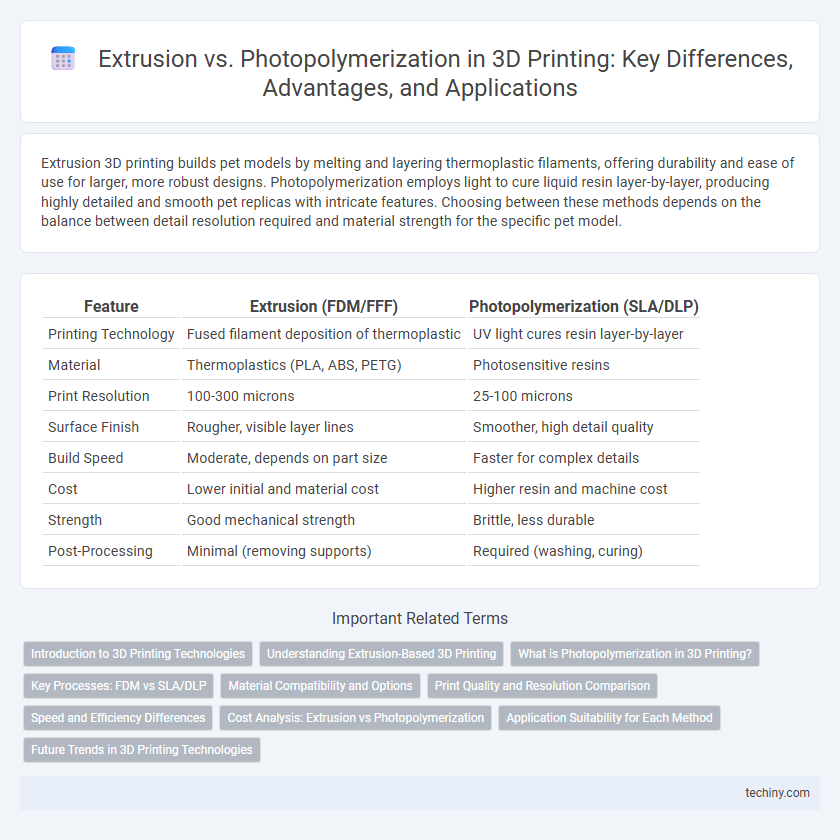Extrusion 3D printing builds pet models by melting and layering thermoplastic filaments, offering durability and ease of use for larger, more robust designs. Photopolymerization employs light to cure liquid resin layer-by-layer, producing highly detailed and smooth pet replicas with intricate features. Choosing between these methods depends on the balance between detail resolution required and material strength for the specific pet model.
Table of Comparison
| Feature | Extrusion (FDM/FFF) | Photopolymerization (SLA/DLP) |
|---|---|---|
| Printing Technology | Fused filament deposition of thermoplastic | UV light cures resin layer-by-layer |
| Material | Thermoplastics (PLA, ABS, PETG) | Photosensitive resins |
| Print Resolution | 100-300 microns | 25-100 microns |
| Surface Finish | Rougher, visible layer lines | Smoother, high detail quality |
| Build Speed | Moderate, depends on part size | Faster for complex details |
| Cost | Lower initial and material cost | Higher resin and machine cost |
| Strength | Good mechanical strength | Brittle, less durable |
| Post-Processing | Minimal (removing supports) | Required (washing, curing) |
Introduction to 3D Printing Technologies
Extrusion and photopolymerization are two primary 3D printing technologies shaping modern additive manufacturing. Extrusion, commonly known as Fused Deposition Modeling (FDM), uses thermoplastic filaments melted and deposited layer by layer, offering cost-effective prototyping and functional parts with versatile materials like PLA, ABS, and Nylon. Photopolymerization, including Stereolithography (SLA) and Digital Light Processing (DLP), relies on curing resin with UV light, delivering high-resolution and smooth-surfaced prints ideal for detailed models and precision applications.
Understanding Extrusion-Based 3D Printing
Extrusion-based 3D printing, commonly known as Fused Deposition Modeling (FDM), operates by melting thermoplastic filaments and precisely depositing them layer by layer to create three-dimensional objects. This method offers versatility in material choices such as PLA, ABS, and PETG, making it ideal for prototyping and functional parts with moderate mechanical strength. Compared to photopolymerization techniques like SLA, extrusion-based printing excels in cost-effectiveness and ease of use but typically yields lower surface finish quality and resolution.
What is Photopolymerization in 3D Printing?
Photopolymerization in 3D printing is a process that uses light to cure and solidify liquid resin layer by layer, creating highly detailed and smooth objects. This technique relies on ultraviolet (UV) light or laser to trigger a chemical reaction that hardens the photopolymer resin, enabling precise control over complex geometries. Photopolymerization is widely used in applications requiring fine resolution and surface finish, such as dental models, jewelry, and prototyping.
Key Processes: FDM vs SLA/DLP
Fused Deposition Modeling (FDM) extrudes thermoplastic filaments layer-by-layer to create objects, offering affordability and material versatility ideal for prototyping. Stereolithography (SLA) and Digital Light Processing (DLP) utilize photopolymerization by curing liquid resin with laser or digital light, delivering higher resolution and smoother surface finishes. FDM excels in strength and usability for functional parts, while SLA/DLP provide superior detail and precision for intricate designs.
Material Compatibility and Options
Extrusion-based 3D printing supports a wide range of thermoplastics such as PLA, ABS, PETG, and TPU, allowing for versatile mechanical properties and color options. Photopolymerization techniques, including SLA and DLP, primarily use resin-based materials that offer high resolution and smooth surface finishes but are limited in flexibility and temperature resistance. Material compatibility varies significantly, with extrusion favoring durable and functional parts, while photopolymerization excels in precision and complex geometries.
Print Quality and Resolution Comparison
Extrusion-based 3D printing typically delivers lower resolution and surface finish compared to photopolymerization methods, due to the layer-by-layer deposition of molten filament that can result in visible layer lines and rough textures. Photopolymerization, such as stereolithography (SLA) or digital light processing (DLP), uses light to cure resin with precision, achieving finer details and smoother surfaces with resolutions often under 100 microns. Higher print quality and resolution in photopolymerization make it ideal for intricate prototypes and models requiring detailed features and superior aesthetics.
Speed and Efficiency Differences
Extrusion-based 3D printing typically offers faster print speeds due to its straightforward material deposition process, enabling rapid layer-by-layer construction. Photopolymerization, including SLA and DLP technologies, delivers higher precision and surface finish but generally requires longer curing times per layer, reducing overall speed. Efficiency in extrusion is enhanced by inexpensive materials and minimal post-processing, whereas photopolymerization demands careful handling of resins and additional post-curing steps, impacting throughput.
Cost Analysis: Extrusion vs Photopolymerization
Extrusion 3D printing, primarily using Fused Deposition Modeling (FDM), generally offers lower initial investment and material costs compared to photopolymerization techniques like Stereolithography (SLA) or Digital Light Processing (DLP). Photopolymerization requires higher expenses due to specialized resin materials, increased maintenance, and more complex post-processing steps. The overall cost efficiency of extrusion makes it ideal for prototyping and low-volume production, while photopolymerization typically suits applications demanding higher detail despite its premium price.
Application Suitability for Each Method
Extrusion-based 3D printing, particularly FDM, is ideal for creating durable prototypes, functional parts, and large-scale models using thermoplastics like ABS and PLA, making it suitable for automotive, aerospace, and consumer goods industries. Photopolymerization, including SLA and DLP, excels in producing highly detailed, smooth-surfaced objects with complex geometries, often utilized in jewelry, dental, and medical device applications where precision and surface finish are critical. Selecting between extrusion and photopolymerization depends on the required mechanical properties, resolution, and application-specific material compatibilities.
Future Trends in 3D Printing Technologies
Future trends in 3D printing highlight significant advancements in extrusion and photopolymerization techniques, with extrusion evolving to support multi-material and high-temperature printing for enhanced mechanical properties. Photopolymerization is advancing through faster, higher-resolution processes such as Continuous Liquid Interface Production (CLIP) and two-photon polymerization, enabling complex microstructures with superior surface finishes. Integration of AI-driven process optimization and sustainable resin development is accelerating innovation in both methods, promising increased efficiency and broader industrial applications.
Extrusion vs Photopolymerization Infographic

 techiny.com
techiny.com